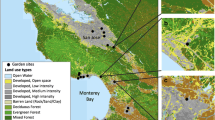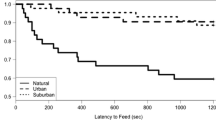Abstract
Urban landscapes such as college campuses, arboretums, and backyards provide excellent habitats for education and research into animal behavior. We investigated aspects of the foraging activity of free-ranging Eastern cottontails (Sylvilagus floridanus) on the campuses of the University of Illinois at Chicago and Lawrence University. We used giving-up densities (GUD) to test for habitat selection and patch-use behavior by cottontails inhabiting an urban landscape with a gradient of shrub and tree cover. In addition, we used small garden fences around feeding trays to test their effect as obstacles to the foraging of cottontails. Foraging activity was significantly higher under cover than in the open. GUDs were significantly lower in proximity to cover; in addition, shrubs were preferred over low-laying trees as the source of cover. Camera trap photos revealed solitary foraging, highest in the late afternoon and early morning. We demonstrated that surrounding a food patch with 3 or 4 fences increased the cottontails’ GUDs. Similar to natural habitats, urban landscapes offer heterogeneous environments that force their inhabitants to allocate their foraging activity according to their perceived stresses. Studying effect of habitat complexity on foraging responses provides useful tools to study ecological interactions and can help minimize the damage that cottontails cause within urban environments such as city parks and private gardens.




Similar content being viewed by others
References
Abu Baker MA, Brown JS (2009) Patch area, substrate depth, and richness affect giving-up densities: a test with mourning doves and cottontail rabbits. Oikos 118:1721–1731
Abu Baker MA, Brown JS (2010) Islands of fear: effects of wooded patches on habitat suitability of the striped mouse in a South African grassland. Funct Ecol 24:1313–1322
Abu Baker MA, Emerson SE, Brown JS (2015) Studying foraging ecology on school and college campuses: a practical guide to measuring foraging behavior using urban wildlife. Am Biol Teach (in press)
Althoff DA, Storm GL, Dewalle DR (1997) Daytime habitat selection by cottontails in central Pennsylvania. J Wildl Manag 61:450–459
Bedoya-Perez MA, Carthey AJR, Mella VSA, McArthur C, Banks PB (2013) A practical guide to avoid giving up on giving-up densities. Behav Ecol Sociobiol 67:1541–1553
Bertolino S, Perrone A, Gola L, Viterbi R (2011) Population density and habitat use of the introduced eastern cottontail (Sylvilagus floridanus) compared to the native European hare (Lepus europaeus). Zool Stud 50:315–326
Bock CE, Jones ZF, Bock JH (2006) Abundance of cottontails (Sylvilagus) in an exurbanizing southwestern savanna. Southwest Nat 51:352–357
Bond BT, Leopold BD, Burger LW Jr, Godwin KD (2001) Movements and home range dynamics of cottontail rabbits in Mississippi. J Wildl Manag 65:1004–1013
Bowers MA, Breland B (1996) Foraging of gray squirrels on an urban–rural gradient: use of the GUD to assess anthropogenic impact. Ecol Appl 6:1135–1142
Bowers MA, Jefferson JL, Kuebler MG (1993) Variation in giving-up densities of foraging chipmunks (Tamias striatus) and squirrels (Sciurus carolinensis). Oikos 66:229–236
Brown JS (1988) Patch use as an indicator of habitat preference, predation risk, and competition. Behav Ecol Sociobiol 22:37–47
Brown JS, Kotler BP (2004) Hazardous duty pay and the foraging cost of predation. Ecol Lett 7:999–1014
Chapman JA, Hockman JG, Ojeda MM (1980) Sylvilagus floridanus. Mamm Species 36:1–8
Conover MR (2010) Resolving human-wildlife conflicts: the science of wildlife damage management. CRC Press, Boca Raton
Cox EW, Garrott RA, Cary JR (1997) Effect of supplemental cover on survival of snowshoe hares and cottontail rabbits in patchy habitat. Can J Zool 75:1357–1363
Craven SR (1994) Cottontail rabbits. In: Hygnstrom SE, Timm RM, Larson GE (eds) Prevention and control of wildlife damage. University of Nebraska-Lincoln, Lincoln, pp D75–D80
Ditchkoff SS, Saalfeld ST, Gibson CJ (2006) Animal behavior in urban ecosystems: modifications due to human-induced stress. Urban Ecosyst 9:5–12
Emerson SE, Brown JS, Linden JD (2011) Identifying Sykes’ monkeys’, Cercopithecus albogularis erythrarchus, axes of fear through patch use. Anim Behav 81:455–462
Hoffman RS, Smith AT (2005) Order Lagomorpha. In: Wilson DE, Reeder DM (eds) Mammal species of the world, 3rd edn. Johns Hopkins University Press, Baltimore, p 209–210
Hughes JJ, Ward D (1993) Predation risk and distance to cover affect foraging behavior in Namib Desert gerbils. Anim Behav 46:1243–1245
Hunt VM, Magle SB, Vargas C, Brown AW, Lonsdorf EV, Sacerdote AB, Sorley EJ, Santymire RM (2014) Survival, abundance, and capture rate of eastern cottontail rabbits in an urban park. Urban Ecosyst 17:547–560
Knowlton JL, Graham CH (2010) Using behavioral landscape ecology to predict species’ responses to land-use and climate change. Biol Conserv 143:1342–1354
Lima SL (1998) Stress and decision making under the risk of predation: recent developments from behavioral, reproductive and ecological perspectives. Adv Study Behav 27:215–290
Lima SL, Dill LM (1990) Behavioural decisions made under the risk of predation: a review and prospectus. Can J Zool 68:619–640
Lima SL, Valone TJ, Caraco T (1985) Foraging-effeciency-predation-risk trade-off in the grey squirrel. Anim Behav 33:155–165
Lombardi L, Fernández N, Moreno S (2007) Habitat use and spatial behaviour in the European rabbit in three Mediterranean environments. Basic Appl Ecol 8:453–463
McKinney ML (2002) Urbanization, biodiversity, and conservation. Bioscience 52:883–890
Messmer TA (2009) Human–wildlife conflicts: emerging challenges and opportunities. Hum Wildl Confl 3:10–17
Morey PS, Gese EM, Gehrt S (2007) Spatial and temporal variation in the diet of coyotes in the Chicago metropolitan area. Am Midl Nat 158:147–161
Morris DW, Davidson DL (2000) Optimally foraging mice match patch use with habitat differences in fitness. Ecology 81:2061–2066
Morris DW, Kotler BP, Brown JS, Sundararaj V, Ale S (2009) Behavioural indicators for conserving mammal diversity. Ann N Y Acad Sci 1162:334–356
Rosenzweig ML (2003) Win-win ecology: how the earth’s species can survive in the midst of human enterprise. Oxford University Press, New York
Shochat E, Lerman SB, Katti M, Lewis DB (2004) Linking optimal foraging behavior to bird community structure in an urban-desert landscape: field experiments with artificial food patches. Am Nat 164:232–243
Smith DF, Litvaitis JA (1999) Differences in eye size and predator-detection distances of New England and eastern cottontails. Northeast Wildl 54:55–60
Smith DF, Litvaitis JA (2000) Foraging strategies of sympatric lagomorphs: implications for differential success in fragmented landscapes. Can J Zool 78:2134–2141
Smith GC, Prickett AJ, Cowan DP (2007) Costs and benefits of rabbit control options at the local level. Int J Pest Manag 53:317–321
Stephens DW, Brown JS, Ydenberg RC (2007) Foraging: behaviour and ecology. The University of Chicago Press, Chicago
Swihart RK, Yahner RH (1982) Habitat features influencing use of farmstead shelterbelts by eastern cottontail (Sylvilagus floridanus). Am Midl Nat 107:411–414
Thorson JM, Morgan RA, Brown JS, Norman JE (1998) Direct and indirect cues of predatory risk and patch use by fox squirrels and thirteen-lined ground squirrels. Behav Ecol 9:151–157
Trent TT, Rongstad OS (1974) Home range and survival of cottontail rabbits in southwestern Wisconsin. J Wildl Manag 38:459–472
Vidus Rosin A, Meriggi A, Serrano Perez S (2010) Density and habitat requirements of introduced Eastern cottontail Sylvilagus floridanus in northern Italy. Acta Theriol 55:139–151
Wheeler HC, Hik DS (2014) Giving-up densities and foraging behaviour indicate possible effects of shrub encroachment on arctic ground squirrels. Anim Behav 95:1–8
Williams CK, Davey CC, Moore RJ, Hinds LA, Silvers LE, Kerr PJ, French N, Hood GM, Pech RP, Krebs CJ (2007) Population responses to sterility imposed on female European rabbits. J Appl Ecol 44:291–301
Acknowledgments
We are grateful to the staff of the greenhouse at UIC for providing access to the study site. Many thanks to all members of J. S. Brown’s lab and the LU Biology Department, who provided helpful suggestions and assistance during the fieldwork. We also thank Emily Hjalmarson, Emily Schmidt, Kwaku Sarpong, and Nathan Ryan for their assistance with field work.
Author information
Authors and Affiliations
Corresponding author
Rights and permissions
About this article
Cite this article
Abu Baker, M.A., Emerson, S.E. & Brown, J.S. Foraging and habitat use of eastern cottontails (Sylvilagus floridanus) in an urban landscape. Urban Ecosyst 18, 977–987 (2015). https://doi.org/10.1007/s11252-015-0463-7
Published:
Issue Date:
DOI: https://doi.org/10.1007/s11252-015-0463-7




